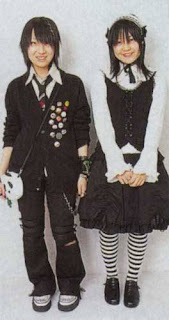I'm recently obsessed with Bliss Foster.
Funnily enough, I accidentally started watching his YouTube channel in tandem with my dear friend Mika, maybe a week after they started watching his content. It's been so fun to discuss his work with someone who ALSO loves fashion and sewing!
Bliss has a million incredible videos, and I highly recommend all of them, but I want to talk about his video on personal style and how his thesis on high fashion can translate to the subcultural fashion I love.
Breaking this post up with a few of my favorite street snaps, since it's so text-heavy!
On the outside looking in, I've been told my style looks extremely unique - and in a way, it is. The fact of the matter, though, is that very little about the way I dress is solely unique to me. The way I style things might be a little different from my source material, but I'm always referring to eras and movements that I find inspiring. I'm a Xerox of a Xerox with a pair of funky earrings added on top, and that is 100% ok with me.
In Bliss's video on personal style, he talks about the "shock of recognition" in fashion. "Shock of recognition" refers to the moment when you find a bit of yourself in a piece of art, and deepen your connection to it through feeling seen and understood. In fashion as a medium, this phenomena works differently. Fashion designers build worlds and profiles of hypothetical people, in order to draw in the customers who see a bit of themselves in these hypotheticals. However, with fashion being a wearable medium, Bliss argues that the shock of recognition in fashion comes not from seeing a bit of yourself in the clothing, but from looking in the mirror and seeing a bit of someone else within you. When you wear these clothes, you complicate the hypothetical worldbuilding the designer did simply by being yourself and living life. Fashion is an inherently collaborative medium, and simply wearing your clothing is a way to collaborate with this designer and their world.
Putting this in the context of lolita and Japanese street fashions is fairly easy, given that every brand is very open about their worldbuilding. Moitie is an abandoned castle decorated with candelabras and dried roses, Baby is a tea party held in an enchanted garden. Juliette et Justine is that terrifying 1960's adaptation of Alice in Wonderland with the taxidermic animals.
Lolita brands present briefs of their ideal customers: the visual kei bangya who loves vampires, the maiden transported to a modern world, the eccentric Victorian woman - and we connect with certain brands more than others because those briefs speak to us. A lot of this calls to mind the "pure maiden" lifestyle lolita that was mythologized and popularized on LiveJournal in the early 2000's. She was beautiful, composed, drank tea, embroidered, didn't watch TV and always minded her manners. She always wore coordinates perfectly, never laughed too loudly, and projected a mysterious aura. These are all ideas of a person that can help give shape to clothing collections, but who doesn't exist in real life.
This is where the complication of the hypothetical comes into play. None of us are the hypothetical perfect person for a brand, but these briefs resonate with a small part of us. Brands like Victorian Maiden and Moitie resonate with me because they combine Gothic motifs with whimsy and softness, but I am not a waifish Gothic Victorian with a collection of hair lockets. We complicate the narratives these brands build by wearing their clothes, and that is how you create personal style within established subcultures. Your clothes are unique because you're the one wearing them, not because they are unique to your closet exclusively. Your style is unique because it is on your body, worn with your accessories that you chose, and worn in a way that is comfortable for you.
Clothing as an art form is perfected by interacting with it in life. The art is not finished when the garment is finished, it is finished when the audience wears it into the world. When you buy a piece, whether you're the first owner or the fifth, you are contributing to that garment's shared history. You are now one of the many people who touched it, gave it purpose, and loved it, from the designer to the seamstress to you. You are seeing parts of others reflected back at you, and that's a really important and special thing. Fashion is a collaborative and community-based medium, and I hope it makes you feel less isolated and alone. I hope you can look at these garments and see parts of others within them. I hope you see yourself, too.
Go out and complicate that hypothetical.






No comments:
Post a Comment